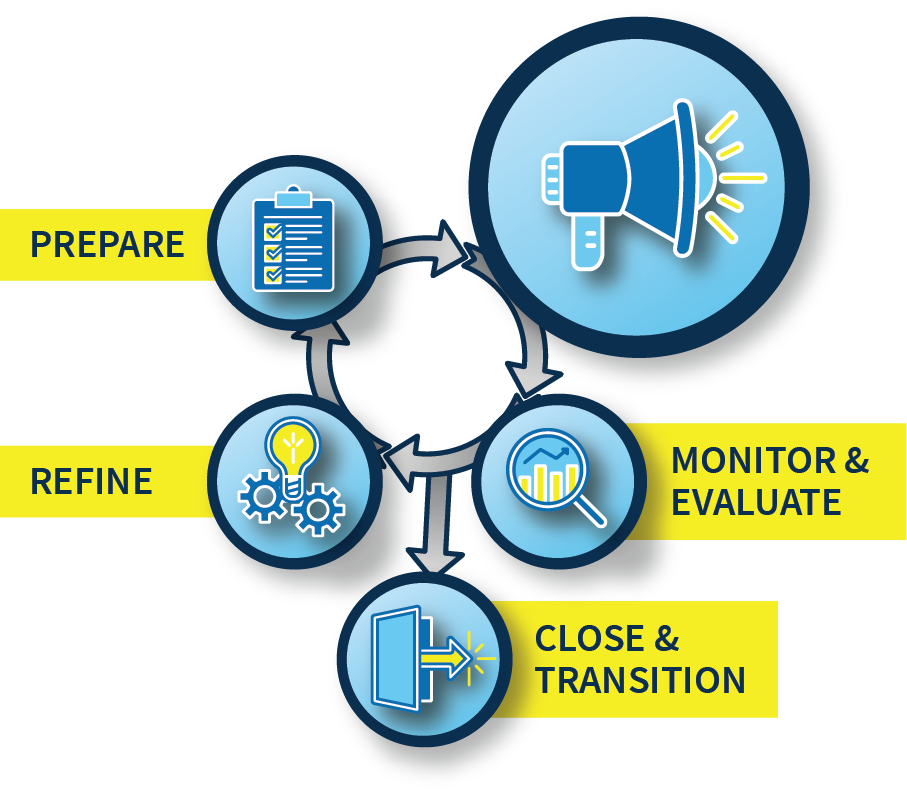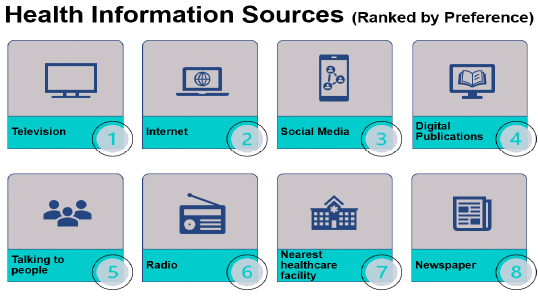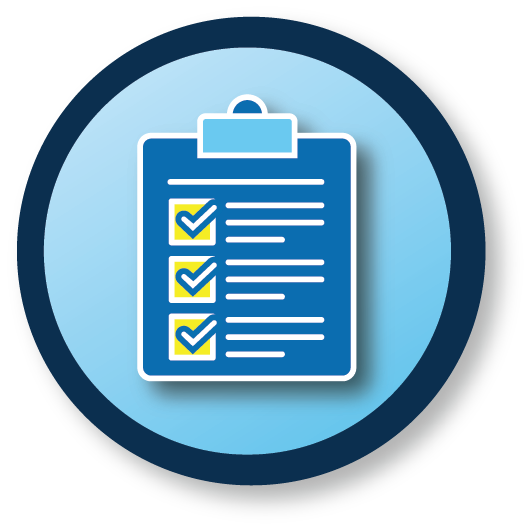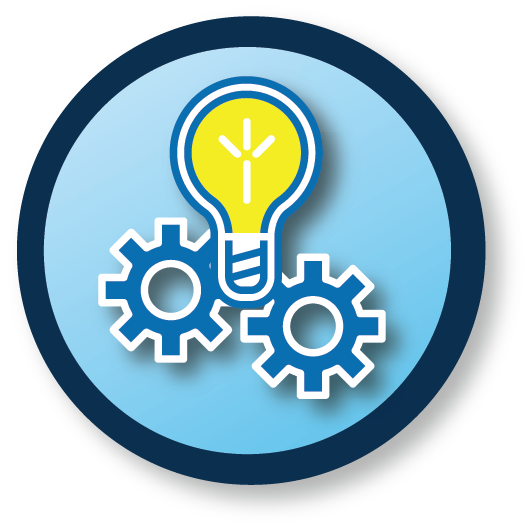Respond
Develop and Execute the Community Activation Campaign


DEVELOP AND EXECUTE THE COMMUNITY ACTIVATION CAMPAIGN

UNDERSTANDING COMMUNITIES

PLAN THE CAMPAIGN: MESSAGE DEVELOPMENT AND DELIVERY

LAUNCH THE CAMPAIGN
DEVELOP AND EXECUTE THE COMMUNITY ACTIVATION CAMPAIGN
Understanding Communities
Additional information about understanding communities
In conjunction with developing a comprehensive awareness about the communities the campaign intends to reach, it is essential for campaign team members to understand the status of clinical science and regulatory activity, their potential impact on the community, and public sentiment regarding government regulations and clinical science. Grounding the CMT in an understanding of how federal or local regulatory decision-making and policies play into the evidentiary science, and vice versa, is central to building effective outreach materials, talking points, and frequently asked questions (FAQs).
ASSESS THE EMERGENCY’S IMPACT UPON COMMUNITIES
Whereas one community may appear resilient and relatively untouched by a crisis, other communities may suffer a disproportionate burden. Health insurance access and coverage, access to technology (e.g., smart phones, internet), employment status, immigration status, language skills, access to healthcare facilities, and feelings of being left behind may compound these existing inequities.
|
Community and individual social norms, values, politics, and health beliefs will also influence behavior during an emergency. These collective cultural aspects impact where community members seek information and whom they trust as messengers. They generally have deep roots in a community and can sometimes be related to historical injustices. Continuously bearing the brunt of crises can lead to collective trauma that can persist across generations and shape behavioral patterns (Saul, 2013).
Key Decisions and Activities to Assess the Emergency’s Impact
- Identify populations impacted (e.g., by geography and demographics) as well as any existing and potential disproportionate impacts.
- Determine population segments and focus communities based on campaign objectives, noting that resource constraints may necessitate difficult decisions to prioritize certain segments in the response.
- Develop a framework to continually monitor and assess the emergency’s ongoing impact on communities as part of the monitoring and evaluation framework (Establish the Monitoring and Evaluation Framework). Consider incorporating data from vulnerability indices like Center for Disease Control and Prevention’s (CDC) Social Vulnerability Index (CDC, 2021).
Conduct an Audience Analysis
|
Key Considerations to Understand the Audience
- Social norms, values, beliefs, fears, and social networks can impact health information-seeking and active engagement in wellness and disease prevention.
- By understanding the characteristics of each community and preparing a generalized model or “persona” for the community of focus, these insights can be applied to the strategic and tactical decisions for community activation.
- Focus groups, community advisory boards, in- depth interviews, questionnaires, and/or surveys can be used to study the community of interest. Consider each methodology’s advantages and disadvantages in terms of time to complete, cost to execute, quality of research, potential bias, and impact to the community. See the tools Guided Interview Development Worksheet and Cultural Considerations for Guided Interview Development Worksheet for an interview discussion planning checklist and cultural considerations for guided interview development worksheet.
|
Key Considerations to Understand the Audience’s Environment
Conditions in the places where people live, learn, and work affect health risks and outcomes. Vocation, living spaces, and community geography may make it difficult for individuals to avoid exposure, potentially exacerbating disease transmission. When planning communication campaigns, consider social determinants of health to make appropriate requests of the audience and understand how the message(s) will best reach and resonate with them. Consider the following:
- Disparities in risk exposure: During a pandemic, individuals will have unequal levels of possible risk exposure.
- Essential workers such as bus drivers, clerks, caregivers, and warehouse employees may not have the same ability to be physically distant or as available for community activation requests as individuals from other professions.
- Individuals in the intended audience may have experienced homelessness or crowded living spaces, such as shelters or multigenerational households, and may not have access to online campaign materials. Consider a broad approach that uses various channels to reach the audience.
- Health services and accessibility: Not all communities have equitable access to healthcare providers and services.
- Identify local health centers or other sites where clinical care or community services are trusted resources for the community.
- Consider if the campaign will be impacted by transportation or other accessibility limitations. If so, identify solutions such as free or low-cost transportation options and extended hours of operation.
- Underlying health conditions: Underlying health conditions can disproportionately affect certain populations and can compound hospitalizations and deaths caused by a PHE. Consider the burden of the ask for individuals from these communities and identify solutions that help with translation, understanding, and ability to participate.
- Health inequities: Design the campaign to provide equitable benefit to all impacted populations. PHEs can affect under-resourced and underserved communities more than other communities and exacerbate existing negative health outcomes (Section 3.1.1).
- While there may be disparities in outcomes for unknown reasons (e.g., the science may not yet discern why certain treatments are not as effective for certain populations), it is crucial to have a plan to address the needs of underserved and/or disproportionately affected populations and to continuously strive for equitable solutions.
- Cultural aspects of a community. The methodology chosen for the analysis must take cultural aspects into consideration with questions designed to understand social norms, values, beliefs, and social networks. Consider if the campaign will be impacted by transportation or other accessibility limitations. If so, identify solutions such as free or low-cost transportation options and extended hours of operation.
|
Other Considerations in Audience Analysis
As part of the audience analysis, conduct an initial scan of literature and other resources to capture documented behaviors or beliefs.
- An online survey can provide quick, targeted insight. Note that survey questions, the data collection plan, and data analysis should be developed and validated by appropriate subject matter experts. See Appendix I for an annotated online survey.
- Data from the survey can be applied across campaign tasks (e.g., refining targeted messages).
- Note that any public information collection will require adherence to statutory guidance, such as privacy laws and public burden reductions, and that certain information collection activities may need waivers approved by authorities.
|
Conduct a Social Listening Scan
Social listening is the process of tracking and analyzing mentions of key words, phrases, or complex queries across social media and the web (Stewart and Arnold, 2018). Social media can help promote access to important health information and can also present challenges to consistent and accurate messaging. Misleading information can spread quickly and reach more people than proven fact-based information through use of fear tactics, uncertainty, and audience lack of knowledge (Sell, Hosangadi, and Trotochaud, 2020). Online misinformation and disinformation pose barriers to effective emergency preparedness and response (Scannell et al., 2021).
Social listening identifies the language used and topics discussed online during the PHE. These analyses can inform the design of campaigns, get ahead of misinformation and disinformation, and identify credible influencers who may serve as trusted messengers for the campaign.
|
Key Considerations to Conduct a Social Listening Analysis
- Social listening must be timely. Online discourse changes rapidly. Real-time feedback from local contexts is ideal, but at
minimum, weekly social listening reports should be analyzed. - Develop an agile online social listening strategy that can be continuously refined based on online discussion.
- Software exists to help systematize social listening. Examples of social media monitoring software include Talkwalker, Twitter API, and Botometer®.
- Misinformation and disinformation can be amplified by social bots, which are computer algorithms that automatically produce online content and interact with humans, trying to emulate or alter human behavior (Allem and Ferrara, 2018). These bots can proliferate messages quicker than organic content from human users, introducing the potential for rapid and broad amplification of misinformation and/or disinformation.
|
Integrate Scientific Finding and the Research Community
|
It is likely that accumulated scientific knowledge will lead to changes in decisions at a rapid pace, potentially making long-awaited findings from Randomized Control Trials (RCTs) less impactful. RCTs compare outcomes between treated and untreated or “usual care” patients. It can be challenging to recruit patients into RCTs during an emergency, and it is common for the definition of “usual care” to change within weeks or months.
- In some cases, the PHE may be over before RCTs report out completely. The campaign must balance the desire for RCT outcomes with more timely data from clinical practice and observational research.
- Expect a charged environment as clinicians and regulators grapple with the best available, but potentially incomplete, evidence.
- Experienced physicians and scientists from across the globe will debate the evidence in a public manner, which presents a risk of misinterpretation by media and interest groups.
|
Key Decisions and Activities to Integrate Scientific Findings
- Identify or establish a clinical and scientific advisory group.
- Determine if there is an existing clinical and scientific advisory body available to convene and advise on the crisis as it unfolds. If not, announce the need to the scientific community and quickly establish a group of willing professionals. See the tool Characteristics of a Clinical and Scientific Advisory Group for characteristics of a clinical and scientific advisory group.
- Keep a focus on the groups that are most at risk.
- The clinical and research advisory body should take particular attention to review research related to at-risk populations. New solutions designed to help the most disproportionately affected or underserved will ultimately be the most effective at mitigating the disaster for society.
- Address misinformation and disinformation.
- Establish a consistent process and cadence for addressing misinformation and disinformation. Findings from social listening analyses should be shared with clinicians or scientists to help determine if a mitigation intervention is warranted. Based on their review, enhanced public education and countermeasures may be devised to promote a scientifically accurate public discourse.
- Develop scientific reports with the latest research updates for the CMT and oversight team.
- These updates may include recommendations for the communication team on messaging, and/or identifying potential opportunities with trusted voices in the community. Build answers regarding the latest science and research to be readily available for the CMT and others.
- Engage trusted and credible voices in the scientific community.
- Provide media training and tools (e.g., talking points) for those who will be asked to publicly amplify campaign messages.
- Explain regulatory affairs to stakeholders.
- During a PHE, expect a compressed timeline for the development of evidence and the regulatory approvals process for both diagnostics and therapeutics.
- Typically, it takes years for a new medication to be tested for safety and efficacy, to gain approval as a new treatment, and for public and private health insurers to develop therapeutic payment and administration policies.
- During a pandemic, it is likely that existing drugs will be re-purposed as potentially helpful, and new treatments may be created. Expect the Food and Drug Administration (FDA) to use temporary designations such as expanded access programs or emergency use authorizations for promising therapeutics while more definitive evidence is generated. If indicated, the campaign team must closely monitor this process for updated guidance.
- Anticipate evolving risk.
- Epidemics, pandemics, syndemics, and natural disasters are unpredictable in the short term. The oversight team must evaluate developing risks and anticipate scenarios of both a worsening and an improving crisis. Use the advisory group to help develop solutions for evolving threats. This is a key activity for developing resiliency during a crisis.
|
Plan the Campaign: Message Development and Delivery
Develop a Communication Strategic Action Plan
A communication strategy establishes the approach for the campaign, leveraging insights from foundational research to understand the target audience, how the behavior change will benefit them, and what actions they should take (Section 3.1). The strategy should include specific goals and objectives, as well as an implementation plan to outline tactical decisions and activities, such as development of key messages and optimal communication vehicles to reach the audience (National Institutes of Health [NIH], n.d.).
Key Decisions and Activities to Develop a Communication Strategic Action Plan
- Define the goals and objectives.
- Identify the desired health behavior change (goal) and the specific objectives that will support its accomplishment. Make sure the objectives are SMART – Specific, Measurable, Achievable, Realistic, and Time-based.
- Tie goals and objectives to the desired outcomes of the response strategy.
- Define the tactical and operational metrics.
- Metrics will help measure whether the communication strategy is achieving its desired outcomes.
- Identify the data sources from the start and establish the baselines to identify progress towards the goals.
- Develop a budget.
- The campaign budget should allocate resources for paid media, advertising, and any associated digital services costs, such as website and other resource development and management, hosting, and internet Search Engine Optimization (SEO).
- Identify existing resources and address gaps.Confirm whether federal staff or external entities have been tasked with full or shared responsibilities for developing and executing the strategy.
- Secure production resources.
- Identify existing production resources (e.g., video studios, digital services) or work with external entities to develop and maintain campaign-specific supports.
- Ensure the plan addresses the uniqueness of the target audience.
- One size does not fit all when communicating the messages.
- Leverage results from the audience analysis, partner engagement, and other formative analyses to tailor the communication plan to the intended audiences. Consider how geography, demographics, literacy, culture, and language may affect how audiences interpret planned messages.
- Include tactics to “pull” the audience into the content.
- With the increasing proliferation of online communications and competing pitches for attention, it is easy for the audience to miss online content they do not actively seek (i.e., content that is “pushed” to them).
- To address this, devise tactics to draw the audience into the campaign by creating engaging content (blog posts, online forums, social media conversations) relevant to the audience’s interest and needs.
- Use keywords to help drive SEO so the campaign is prominently displayed in organic web search results as the audience looks for related information online.
- Select communication vehicles that will resonate with the audience.
- Determine the appropriate media types (media mix) to best reach the target audience, including specific vehicles (e.g., publications, stations) for each medium. See the resource Media Formats and their Key Features for a sample list of media formats and their key features.
- Develop or adopt existing crisis communication plans.
- The campaign management team (CMT) and the oversight team must also consider whether existing crisis communication plans, federal or local government public affairs protocols, or other specific resources should be consulted or included in the campaign plans in conjunction with larger public health emergency (PHE) plans.
- Create a tactical plan for community outreach activities and promotions.
- This plan could be a tool to share with local officials, organizations, healthcare professionals, and others within specific communities. It should include goals and objectives, tailored messages and talking points, and communication channels to guide conversations with community partners.
Design Messages and Creative Assets
Develop the Messages
Several decisions will shape the development of effective campaign messages. Audience analyses and other formative research will inform the message design, so it resonates with the audience and prompts the desired behavior change (Maibach,1995).
|
Key Decisions and Activities to Develop Campaign Messages
When designing messages to achieve a positive health behavior change, consider the following (MITRE Corporation, n.d.):
- Amplify community beliefs, values, and social norms.
- The audience analysis should have identified features regarding the communities included in the campaign that highlight differences between regions or other distinctions.
- Chances are that the analyses surfaced a need to address different groups with values, beliefs, and social norms unique to their community.
- For example, a community’s social norms and values may be that its members do what is best for the greater good. Messages for that situation must positively appeal to the sense of community versus the individual’s needs.
- By amplifying a community’sb eliefs, values, and social norms, the messaging is more likely to resonate and be received by the audience.
- It is critical to identify the specific beliefs that are related to the campaign-targeted behavior change (Zhao, 2020).
- Facilitate a sense of personal agency to achieve the desired health behavior change.
- In simple terms, this means building the audience’s confidence that they are in control and can achieve the recommended behavior change.
- If the behavior change is perceived as unachievable by the audience, they are more likely to disregard the message(s) and not adopt the change (Ort, Siegenthaler, and Fahr, 2021).
- Consider the health literacy of the audience.
- Addressing health literacy can potentially reduce barriers to adoption of behaviors and lessen health inequities (Wittenber et al., 2020).
- Use plain language, particularly when talking with a general audience, to ensure everyone can easily understand the information presented to them. This helps to communicate health information more effectively by making the message(s) clear and concise (Grene, Cleary, and Marcus-Quinn, 2017).
- Consider the use of appropriate visual communication.
- Appropriate visual communication can improve decision-making, change attitudes, and reduce risk behavior (Garcia-Retamero, 2013).
|
- Communicate scientific truth and clinical guidance.
- Team members responsible for outreach and education communication should routinely confer with members of the clinical and research community for scientific guidance in the development of outreach materials and programs.
- All materials, such as pamphlets, blog posts, radio spots, interview guides, frequently asked questions (FAQs), and social media posts should be designed using updated scientific guidance and use plain language to explain complicated topics.
- Clinical team members can help integrate the latest clinical guidelines (e.g., from the Centers for Disease Control and Prevention [CDC], NIH, professional societies) into the messaging.
- Communicate uncertainty regarding disease risk, diagnostics, and treatments with empathy. Practicing clinicians who are accustomed to working directly with patients should be routinely consulted to achieve effective messaging.
Develop Creative Assets
The materials developed for community activation, the messages conveyed, and the branding design are all incorporated into the campaign’s communication materials, or creative assets. These assets can include such products as brochures, graphics, videos, stickers, personal testimonials, blog posts, newsletters, fact sheets, and posters.
Key Decisions and Activities to Develop Creative Assets
- Create assets that are culturally appropriate.
- Ensure that the language, graphics, and photos used in the creative assets are culturally appropriate for the target audience.
- When using photos of people, ensure they are representative of the audience, since individuals often will relate to photos of people who are like themselves.
- Consider including the target audience in asset development.
- This approach can consist of a community advisory group or focus groups.
- Community participation in the development of the assets provides valuable information to ensure that the messaging will resonate with the audience (Allen, n.d.).
|
- Develop distinctive brand assets.
- Select a logo, font, and color palette that represent the campaign and use these features consistently in all creative assets.
- This builds strong brand identity for the campaign that is easily recognizable by the audience (Romanuk, 2018).
- Consider visual communication strategies.
- Visuals can simplify complex health messages to make them easier to understand. It is important to consider images that can effectively communicate the message(s) (CDC, 2021a).
- Consider accessibility in the design process.
- For all campaign materials, including the development and hosting of a website with pictures or other graphics, consult an accessibility expert to ensure compliance with regulations like Section 508 of the Rehabilitation Act (1998).
- This ensures the site, and the graphics are accessible to all visitors (Allem and Ferrara, 2018; U.S. Department of Health and Human Services, 2020). Figure 9 below provides a range of examples of The Fight Is In Us (TFIIU) creative assets used in different settings.
- Develop a process for managing, approving, and storing assets. This strengthens quality control, adherence to standards, and ease of maintenance.
- Institute and adhere to a proper file naming convention for organizational purposes.
- As products are developed, modified, and approved, verify that changes to English text or audio are reflected in materials produced in other languages.
|

Figure 9. Sample Creative Assets from The Fight is In Us Campaign
Plan Message Delivery to Communities
Develop a Communication Hub: Message Delivery via Website Landing Pages
A central hub can serve as an information vehicle for the public to learn more about the PHE and to understand how they can engage within their community. Typically, this hub can be a website landing page that communicates information, provides education, calls users to action, and when the PHE is abated, retires the overall campaign with closing messages and graphics.
Key Decisions and Activities to Develop a Communication Hub
- Define communication hub content. Content can include informative text, videos, images and other graphical elements, and bots (software applications that automate simple and repetitive tasks over the internet to connect individuals to additional resources to participate in community activities).
- Will the hub include external resources or connections to sources not managed by the campaign?
- Are there disclaimer sneeded for display in clearly seen formatting to state that these external resources may not be official endorsements or that accessing them may present users with cybersecurity risks?
|
- Establish clinical and research resources for professionals. Develop an online resource page for scientific and clinical communities on the hub. Include research articles, clinical guidelines, and key government documents (e.g., diagnosis and treatment guidance from NIH, Office of Management and Budget, CDC, the Food and Drug Administration).
- Create rules of what materials are to be posted. Differentiate between pre-print, peer-reviewed articles, and opinion pieces. Figure 10 provides an example of the Clinical Research resource page from the TFIIU campaign.

Figure 10. Clinical Research Page from TFIIU Website
- Determine scheduling and development tradeoffs. Time is often the most important factor when scheduling development, due to the time-sensitive nature imposed on development activities to respond to a rapidly evolving PHE.
- When time is critical, development decisions must adjust. There is a constant trade-off between development tasks and development time.
- Define language requirements. Identify which languages are critical to the success of the community activation efforts.
- Campaign budget and time constraints may mean it is not possible to develop an accessible hub with customized content for all languages in the community activation effort, but it may be possible to develop a selection of high-level written (e.g., FAQs, fact sheets) and audiovisual (e.g., videos) outreach materials in key languages.
- Decide on national vs. local engagement. When engaging web visitors, the website may be localized with elements that are familiar to web visitors of a particular geographical area. This approach has the benefits of local impact and familiarity; however, it requires additional development and maintenance work for each version of the website.
- Another approach is to create a single, national page to engage all web visitors, regardless of their geographic locations. The national approach requires less development work, but it lacks customized web content for visitors’ locations.
|
- Capture analytics. Measure and evaluate the effectiveness of the website and include this analysis as part of the monitoring and evaluation framework (Establish the Monitoring and Evaluation Framework) as a mechanism to drive community activation changes. This starts with capturing website analytics data using various online tools. To capture application-specific metrics such as user behavior and actions, add custom instrumentation to the website software.
- Some data could be available by default (e.g., website visits and system uptime).
- Other data is created by adding custom instrumentation to the servers or software. This is a more customized and focused approach to creating useful web analytics data.
- Development schedules must allocate additional time for adding instrumentation to the software.
- Consider User Interface (UI)/User Experience (UX). Address UI/UX through design choices that make a good first impression, encourage users to return, or encourage users to act on an important activity.
- A clear UI/UX design encourages more website visits and engagement and better outcomes for the campaign. Figure 11 illustrates the intended UX for the TFIIU regional landing pages.
- Conduct UX Testing. Consider using A/B testing, which can provide valuable data for design and development decisions for websites.
- A/B testing offers two versions of a creative asset, with a single aspect altered to assess preferences for one version or the other. This allows the campaign to analyze user engagement data, providing insight into which approach (A or B) is more effective and should be used in future materials (Hartson and Pyla, 2012).

Figure 11. Regional Landing Page Intended User Experience Journey
Identify and Engage Community Partnerships to Deliver and Amplify Messages
A successful community activation program engages in meaningful, trusted partnerships within the communities of focus. When establishing new relationships or strengthening existing ones with community leaders, be clear regarding any funding mechanisms and expectations in maintaining the relationship throughout the campaign and whether engagement after the PHE is beneficial or necessary. Clearly expressing the level of effort community partners are expected to maintain, whether in specific actions or throughout the campaign, allows partners to evaluate their own resources and assess whether their commitment can be maintained for the duration of the PHE.
These conversations can generate trust and mutual respect between the community and the campaign, demonstrating that the federal government recognizes opinion leaders’ roles in the community, both to address the PHE and to provide insights on potential future issues.
Key Decisions and Activities to Engage Community Partners
- Design a strategic action plan for community outreach. Design and execute a plan that aligns with the overall campaign response strategy and desired outcomes.
- This should include stakeholder groups within the communities identified for the campaign, as well as community engagement operational metrics and goals.
- Assemble a community engagement team. The team should include individuals who are familiar with the local market and have existing relationships therein.
- The team serves as primary contact points between the campaign and potential and existing community partners, helping to identify, cultivate, and maintain relationships.
- Develop or identify a tool for tracking partnerships. This tool should be like customer relationship management software that tracks contact information, status, and all partnership activity.
- Research, identify, and vet potential community partners and opinion leaders. Organize the results based on relevance to the campaign, partner type, and potential impact (e.g., number of members/followers, status as a trusted voice) and track this for planning and future analysis.
- Ensure there is a balanced mix of partners and leaders. Depending on campaign goals and focus, partner types to consider can include (but are not limited to) civic organizations, advocacy and professional groups, health systems, local government entities, and religious and cultural organizations. See Figure 12 below for the partner mix achieved in the CCP campaign.
- Create a mechanism to build a snapshot of the campaign’s community ecosystem. Combine information from community partner activities to create targets and track metrics such as the number of prospective partners, number of confirmed partners, partner diversity mix, number of activities completed, activity mix, and activity opportunities.
- This snapshot should beat the overall campaign level and the local level. It may roll up to a dashboard as part of the monitoring and evaluation framework (Establish the Monitoring and Evaluation Framework) to continue to refine the engagement strategy.
- Use the snapshot as a roadmap to launch the community engagement plan.
- Identify and engage key organizations and influencers within the community with whom to form partnerships. Gauge opportunities and obstacles within a region or community, reporting on relevant shifts in local attitudes and behaviors relevant to the PHE and the campaign’s goals.
- The CMT should coordinate and refine tactics, methods, and materials to maximize community engagement opportunities to meet campaign strategic objectives.
|
- Engage medical and public health professionals. Ongoing education regarding prevention, diagnosis, and treatment is needed by medical and public health professionals as well as the public during a PHE.
- The research and scientific advisory group can assist in the creation and promotion of lectures, panel discussions, FAQs, and other guidance for professionals.
- This group informs the campaign and maintains an agile understanding of the threat to communities.
- Create programs with two-way communication as conduits for gaining information from front-line caregivers.
- The research and scientific advisory group can assist in the creation and promotion of lectures, panel discussions, FAQs, and other guidance for professionals.
- Determine formal and informal mechanisms for engagement. Set expectations based on agreements and be respectful of partners’ time and priorities. This is especially important if the partners are voluntary.
- Establish the plan and length of time for partnership operations and confirm agreement and understanding.
- Determine what actions or activities community partners can perform and what they are asked to do on behalf of the campaign. Community partners have a range of capacities to perform these requests.
- Divide these requests into high-level and more tactical categories, based on their impact, partners’ usual operating practices, and willingness of partner organizations or individual champions and leaders to take on new roles or serve as spokespeople for the campaign.
- Ask partners to amplify the message or messages. This can include campaign materials distribution, specific media production participation, resource development and testing, or more advanced campaign contributions, such as recruiting additional partners or identifying community individuals for campaign activities.
- Keep partners engaged and be considerate of competing priorities. To make community partnerships mutually beneficial, maintain ongoing dialogue to respond to partners’ needs. Remain sensitive to their challenges and cultural norms. Be respectful that they also are managing their communities’ ongoing needs while supporting campaign requests. Depending on the partner, make requests easy and straightforward (e.g., provide the ability to copy and paste content to share on their own channels).
- Communicate that the campaign is temporary and will end or transition. Being transparent regarding the discrete nature of the campaign at the beginning helps partners to understand what to expect and for how long. It can also help them plan for local long-term sustainability to support their constituency once the campaign ends.
Message Delivery via Media Channels
The right communication vehicles are critical for the messages to reach the target audience (Zhao, 2020). The audience analysis helps shape decisions on preferred communication channels that could be ideal engagement tools for delivering the campaign message(s). Selecting communication channels not used by the target audience may result in failure to reach and engage them and could hinder achievement of the desired health behavior change.
Communication channels can include traditional mass media such as advertisement placement on television, radio, and newspapers; social media and websites placement; and alternate media forms such as promotional events, social networks, and existing communication channels within the community setting.
|
Key Decisions and Activities to Select Media Types and Channels
- Conduct a media scan to understand the media environment.
- Identify potential media outlets in the community/region of focus and assess their overall tone, target audience reach, and resonance with the campaign. Assess the disposition of key talent (e.g., commentators, speakers, writers) and decision- makers (e.g., editorial boards) to ascertain alignment of outlets’ missions and goals with those of the campaign.
- Determine the appropriate media types (media mix) to best reach the target audience.
- Include a mix of paid, earned, owned, and social media.
- Include specific vehicles (e.g.,publications, stations) for each medium.
- Develop a media plan. See the tool Media Operational Plan Checklist for a planning checklist. The media plan can include:
- Schedules to prepare for the frequency and cadence of content dissemination, audience interaction, media engagement, and lead times for internal asset approvals and editorial reviews.
- Considerations for reach (how many individual people will be exposed to the campaign) and frequency (how many times an individual will be exposed to the content).
- Identification of potential message or content overlap across channels, including similar or competing messages external to the campaign.
- Plans for media training for influencers and spokespeople.
- Leverage credible scientific voices. Consult the clinical and scientific advisory body (Integrate Scientific Findings and the Research Community) or conduct an environmental scan to identify trusted voices within the scientific subject area, including whether those sources are local to a specific community or hold national prominence and authority. Provide media training as needed and leverage their expertise and associated relationships for earned media message distribution, such as editorial posts, town hall sessions, or interviews.
|
Launch the Campaign
Additional information about launching the campaign
Campaign leaders must instigate multiple concurrent activities as they prepare to launch education and outreach activities. These efforts generate analyses and resources sufficient to determine when it is appropriate to initiate the campaign, while continuing to collect information after the campaign rollout begins.
Leaders can apply preliminary findings from environmental scans and literature reviews to begin campaign activities, using generalized messaging and existing resources and relationships while completing more thorough campaign research and planning. Campaign leaders can subsequently integrate lessons learned from these early community awareness, education, and activation efforts into more comprehensive campaign plans to improve message effectiveness and expand community partnerships.
When launching the campaign, the oversight and campaign management teams can prioritize campaign action plan components and create a hierarchy for which activities will have the greatest impact immediately and whether others require higher levels of preparation to institute. Strategic implementation and operational planning can include messaging to the public that the campaign will continually monitor the PHE and community needs and adjust the campaign accordingly to achieve strategic objectives.
Test the Messages
Message testing is the process of evaluating different versions of the messages and creative assets during the development cycle. It can help determine which messages or creative assets resonate with the target audience and which inspire the desired actions. Campaign message testing is a critical component in the creation process- small changes to messages can yield significant results.
Methods vary from presenting testing participants with small refinements of an asset or message to solicit feedback, or A/B testing, where different concepts are lined up against each other for evaluation. This can be accomplished via focus groups, guided discussion, surveys or on social media.
|
|









